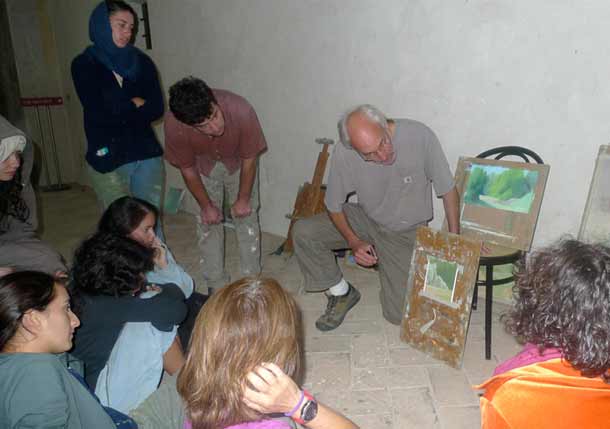
Critique with Stuart Shils at the Certosa
I’d like to offer a glimpse into my recent trip to Rome for a couple of weeks as well as my 4 weeks at the Certosa
Jerusalem Studio School Summer Art Program in Siena, Italy. Hopefully I will avoid boring anyone by having this post be less of a travelogue and instead offer a few thoughts and images of real interest. I want to keep the focus of this blog be about a wide variety of perceptual painters work and issues but not my own work. However, I thought I would make an exception as it perhaps in the context of this Italian setting might raise some issues of interest to a wider audience of perceptual painters.
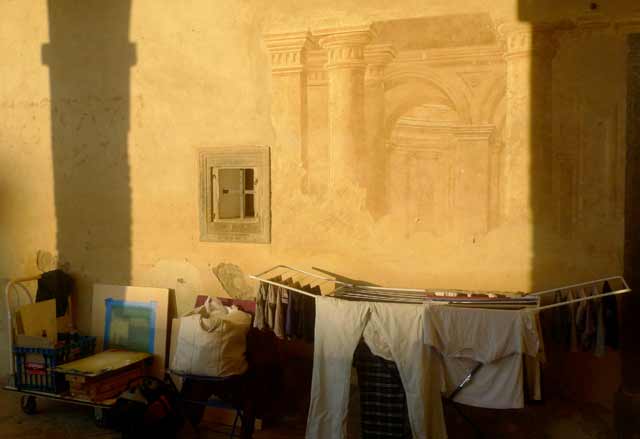 (many photos will have larger versions when clicked)
(many photos will have larger versions when clicked)
The Master’s Laundry
All of the faculty at the Certosa had many thought provoking ways of teaching that often centered around discussing the painting’s structure, focus and visual clarity in responding to the landscape and perception in general. Perhaps the biggest draw for me in choosing this particular venue was not just the stellar reputations of the faculty members but also their more modern emphasis that is still grounded in the great art of the past. That aspects of the work of such painters as Piero della Francesca, Cezanne or Morandi could be discussed along side of ways to respond to painting rows of grapevines or distant houses.
It was refreshing to get to listen and talk about how great landscape painting isn’t about perfecting some system of technique or how to best paint marketable cliches. I’m planning on a future articles with interviews over the next couple of months about the work and thoughts of all of the faculty including Israel Hershberg, Ken Kewley, Stuart Shils, Amy Weiskopf and Yael Jane Scalia. Also I am working on editing a video about Lennart Anderson’s slide talk there.
Many of the other students were older like myself and have been painting for many years but many of the younger students are higher accomplished as well. Despite the level skill or experience a common problem for many of us often stems from lack of clarity or understanding about the need to make paintings with “Significant Form”. How to translate the visual experience into the language of painting that transcends reportage into poetry. I just read this article, “Art and Significant Form” by Clive Bell From Art, 1913. that takes on this issue in depth. Worth the read it you haven’t yet read it.
Painting from observation is great in how it offers us limitless inspiration of form, color, light and mood but nature also seduces us like Sirens and crash upon the rocks by focusing on the seductive minutia and loosing sight of the bigger forms and design. As Stuart Shils likes to say something like; in the landscape all the trees and other shapes crying out to “paint me, no paint me too” you have to be in control and tell them all to sit down and shut up. The goal of the painter should be in orchestrating a poetic response to the subject, to simplify and edit in such a way to best show the viewer what your focus and intent is behind this painting. That in the large masses you find the essential color and value that best represents the infinite range of nuances or the shape that best sums up the most important gestures and play a clear role in the structure of the painting.
Another pervasive issue was avoiding kitsch and cliche. There was much discussion about the need to be visually innovative and to make the painting first about making a powerful underlying abstract design that is the real subject of the painting. Consciously or not, many of us tend to make images that will impress your gallery dealer, friends or family. If a painting subject and style has worked for us in the past we tend to not stray too far from what we expect will sell or win praise. We sometimes conform to what other people’s notions of what is a proper subject or viewpoint. An artist responding to looking a building or olive grove might be more concerned with making the view be easily recognizable rather than the real subject be the experience of the artist looking carefully and showing the magic of light and form transformed into paint.
Future articles will go into these issues in depth and will take on a much greater importance on this blog in general.
My first two weeks in Italy were mainly in Rome where my wife and I stayed in a hotel near the Colosseum. I then went up to Sienna to the Certosa di Pontignano, a 14th Century monastery that is now owned by the University of Siena.
Here are some choice photos that might give you a glimpse of how special a place it is. I can probably talk better responding to specific questions or thoughts so I’m keeping the words to an minimum here. It is good to be back and I look forward to continuing to make this blog be a great place for perceptual painters to find interesting stuff.

Our hotel terrace in Rome with Colosseum view
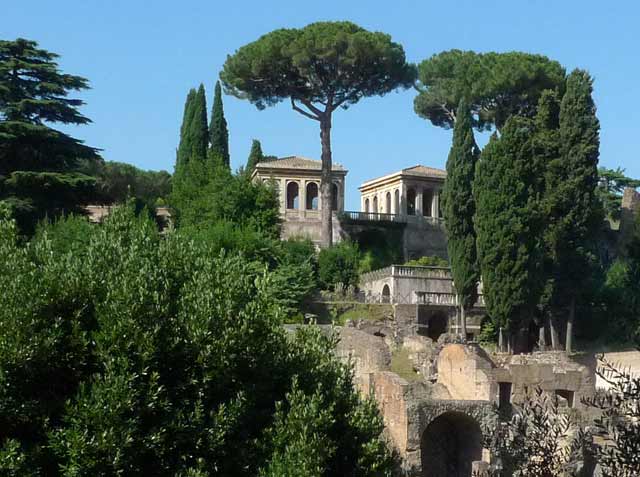
A view in the Forum of Palatine Hill. where the word “Palace” comes from. I spent several hours marveling around the Forum and related sites. Perhaps my favorite experience in Rome.
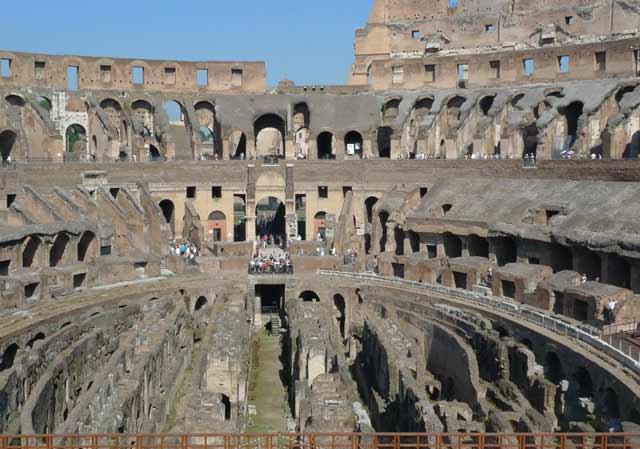
Inside the Colosseum. It’s hard to fathom what people are capable of – such great feats and such great depravity. Reading about what went on here is truly frightening.
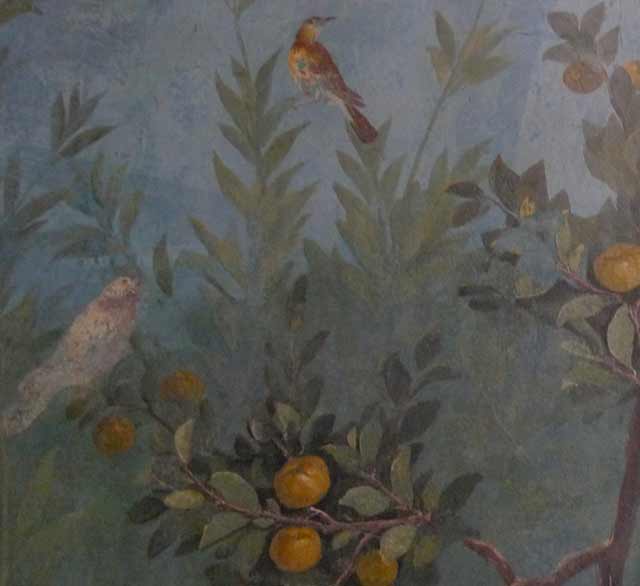
Perhaps one of the earliest landscape and still-life painting in existence. Frescos from the Villa of Livia reinstalled at the Palazzo Massimo
Here is a link to more photos of the Garden Frescoes at the Villa di Livia – … worth a look.
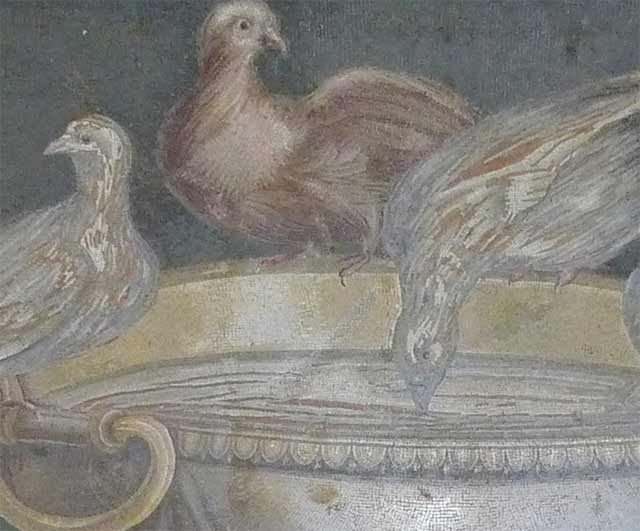
Here is an ancient Roman mosaic I admired also from the Palazzo Massimo in Rome.
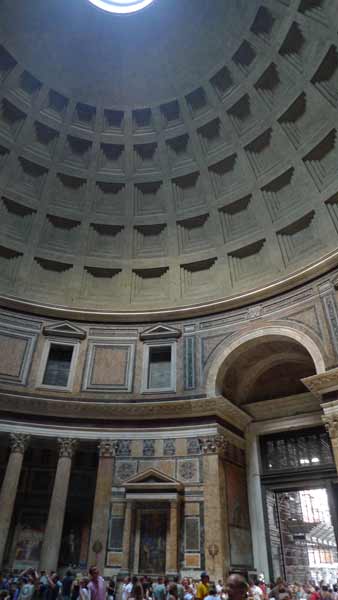
We visited the Pantheon the ultimate temple to all the gods of Ancient Rome and now a Roman Catholic church. The day we visited we were able to appreciate a very rare event I should imagine.
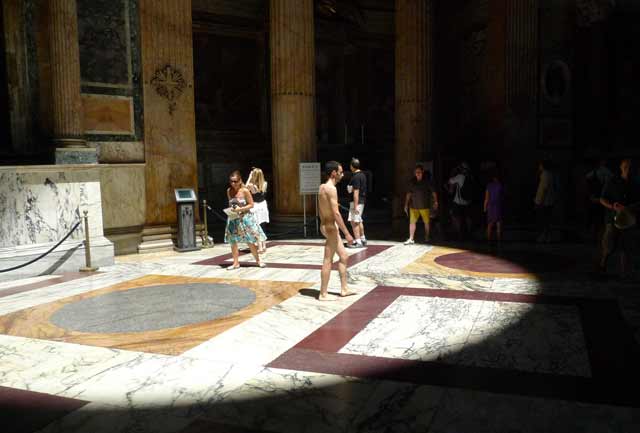
It took a minute or two before it suddenly dawned on people, hey what’s a naked guy doing in the Pantheon! This gentleman clearly wanted to make a point about something – exactly what we never did figure out but it seemed to have to do with Raphael as he lied down here next to Raphael’s tomb.
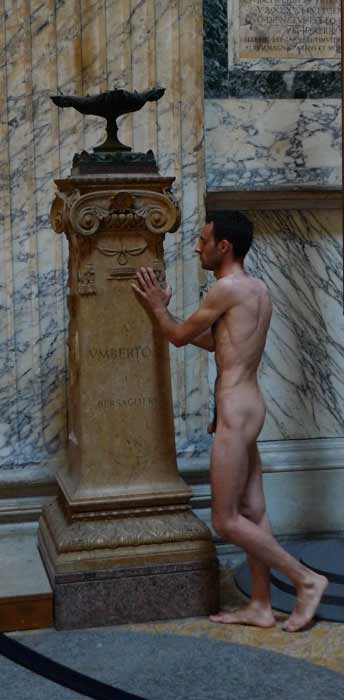
Pagan performance art?
After about 10 or 15 minutes some men dressed up like Roman Centurions came with the police to literally drag him outside the building. Very surreal to say the least.
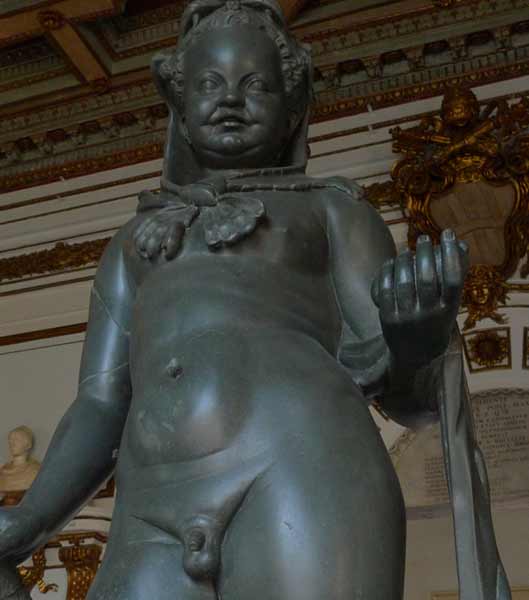
I believe this was a original Greek Bronze of Hercules – This sculpture was truly amazing, seemed timeless. I forget which Museum in Rome it was from.
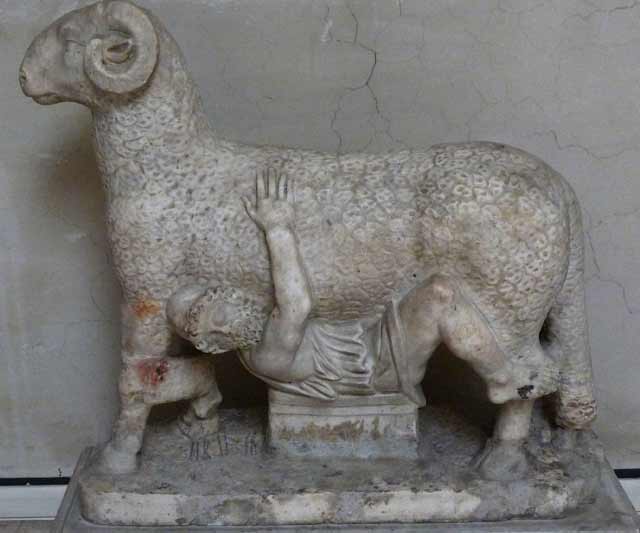
Not sure what the story is here.
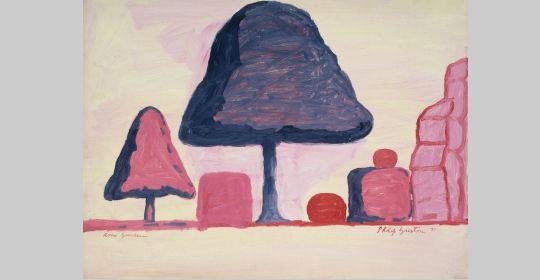
I also saw some more contemporary artists such as the big Philip Guston show of his “Roma Series” with over 40 works, oils on paper, painted by Philip Guston between 1970 and 1971, when he was a Resident at the American Academy in Rome. at the Museo Carlo Bilotti There was also a very good catalog of the show Philip Guston: Roma which I didn’t get yet but soon will be available from Amazon (see link to book).
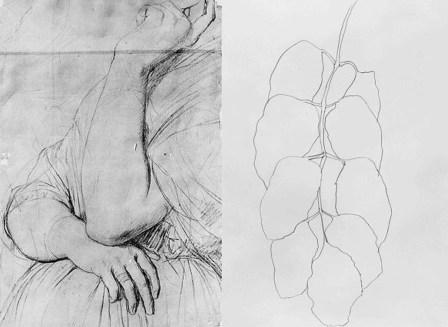
There was also a wonderful show of Jean-Auguste-Dominique Ingres drawings and a few paintings along with drawings and paintings by Ellsworth Kelly at the French Academy at the Villa Medici, Rome. Ingres was once the director of Villa Medici as was the painter Balthus much later.
Perhaps my most memorable experience was much later when I visited Bologna to see the Morandi Museum.
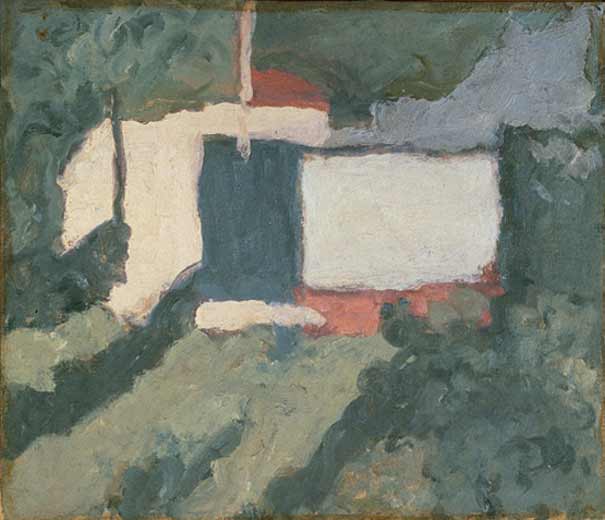
Giorgio Morandi Landscape, 1962 Oil on canvas; 11 7/8 x 13 3/4 in.
The Museo Morandi had a large selection of paintings over 60 I think as well as many drawings and prints that made a very big impression on me. I also saw several terrific landscapes and still-lifes by him at the Vatican Museum but this museum was a life changing event. If you missed the major show of his paintings at the Metropolitan Museum like I sadly did – you can get a very good catalog of the show from this link to Amazon – Giorgio Morandi 1890-1964: Nothing Is More Abstract Than Reality.
Also, much of Janet Abramowicz’s book; Giorgio Morandi: the art of silence is available free online via Google Books. Janet Abramowicz was a teacher’s assistant to Morandi and was a friend to his sisters as well. There are a number of excellent photos and much information. If you wish to order the whole book you can also buy this book from Amazon here. Giorgio Morandi: The Art of Silence
During the program of study at the Certosa I was fortunate to go on the group outings to Florence, Siena and the very special Piero della Francesca tour where we went to Sansepolcro, Arezzo and Urbino.
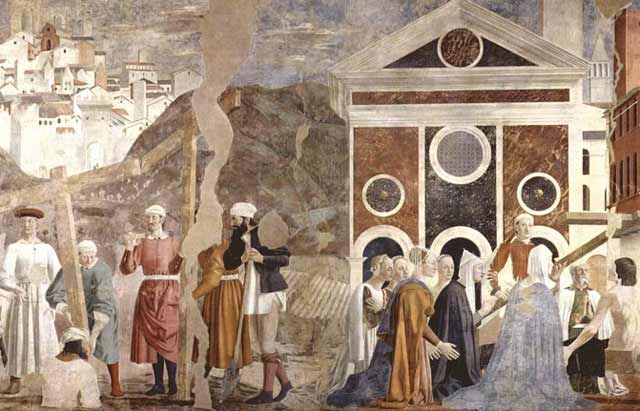
Detail from the Legend of the True Cross 1452-66 Fresco Cycle in the Cappella Maggiore of San Francesco in Arezzo
I found this great link that goes into explaining the iconography and story behind this Fresco Cycle by Piero della Francesca.

Piero della Francesca, The Resurrection (1463) Palazzo Communale of Borgo, Sansepolcro

Flagellation. c. 1470. Mixed technique on panel. 58.4 x 81.5 cm. Galleria Nazionale delle Marche, Urbino, Italy.
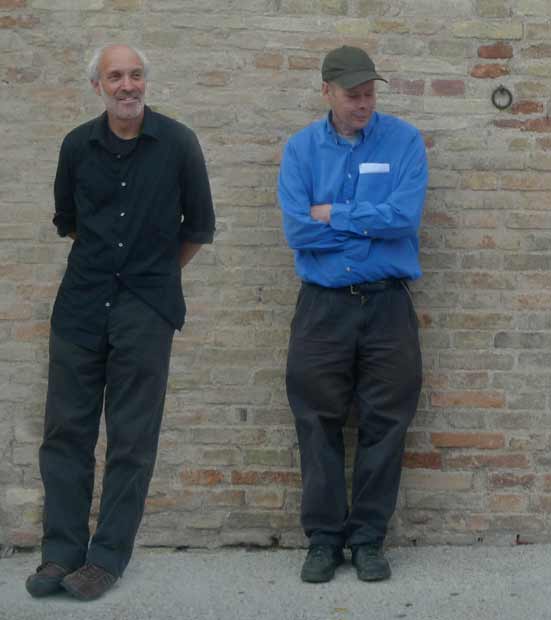
Ken and Stuart leaning on an Urbino wall
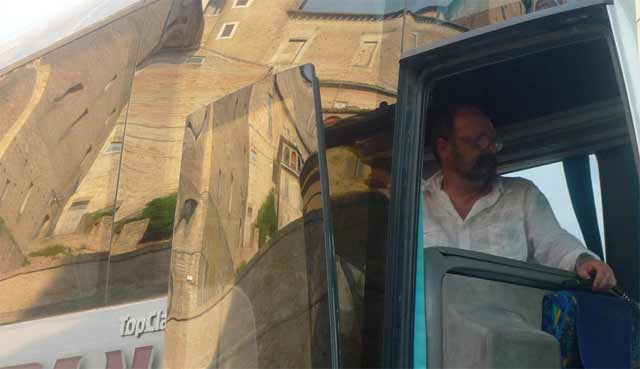
Israel Hershberg with reflections of Urbino
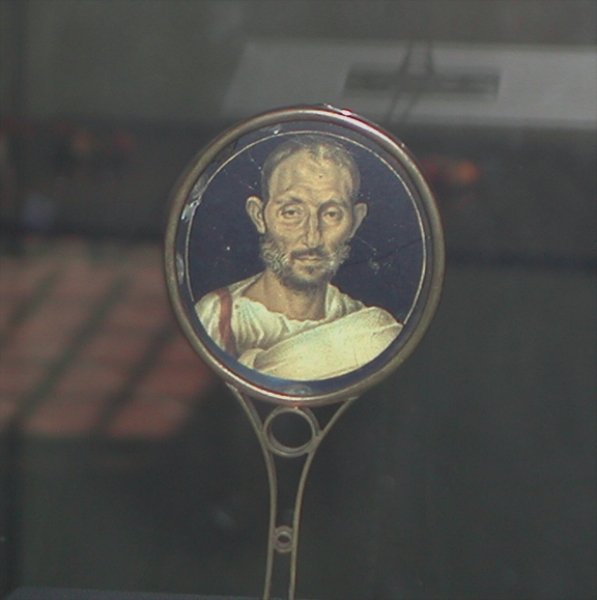
Israel Hershberg’s photo of a marvelous, very rare ancient portrait made from etched glass and silvery gold leaf that he encouraged us all to see. My photo wasn’t remotely as good as the one he took.
Urbino was a spectacular city.
Here are some views from Siena


Finally, here are some more photos of the Certosa which was just outside of Siena.
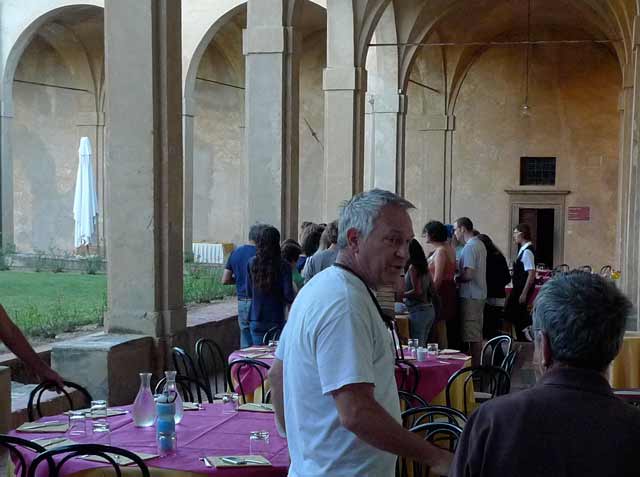
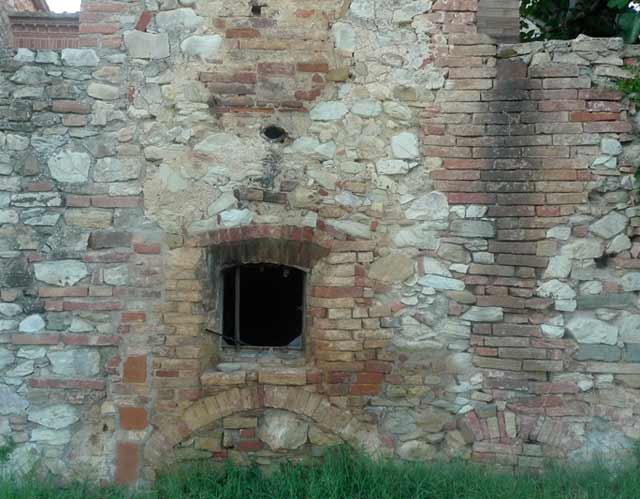

Ken using a collage of brick and tile fragments, stones and other elements to discussed thoughts on color and painting
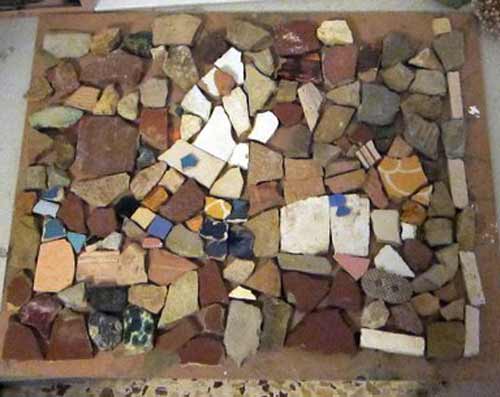
Here is a close up photo (taken by Mark Weber) of his demonstration collage
Finally, here are some of my painting – most are oil on paper and a few oil on linen all are relatively small – nothing much bigger than 14 by 18 inches I think.
Most are one sitting and a couple two sittings.
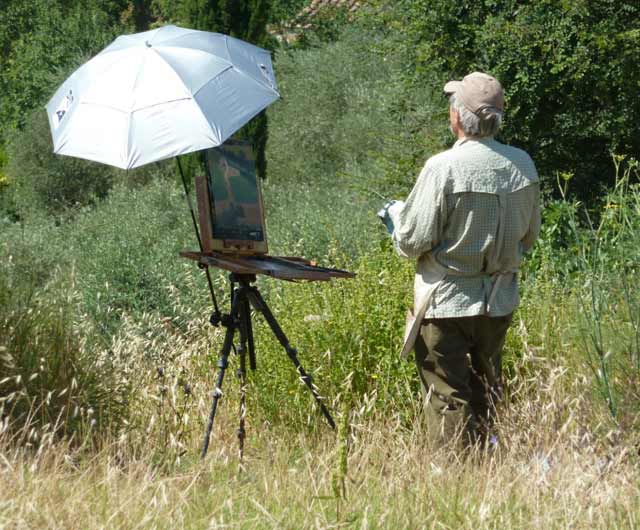
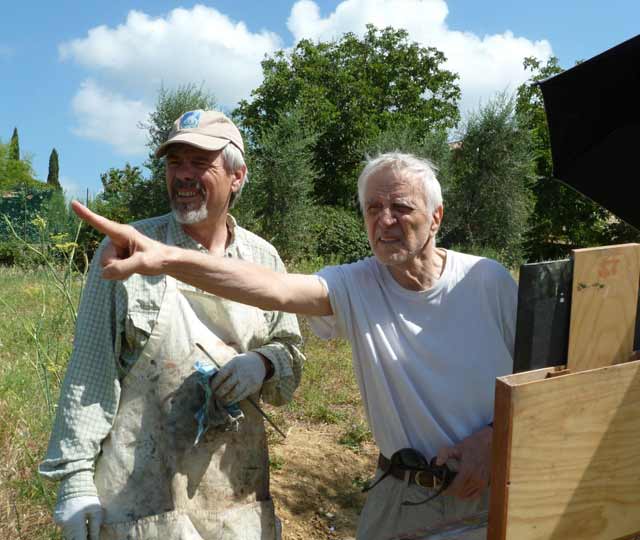
Lennart Anderson pointing out another approach to consider



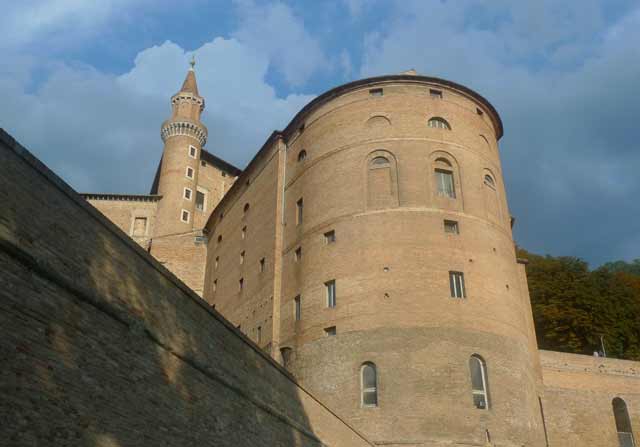
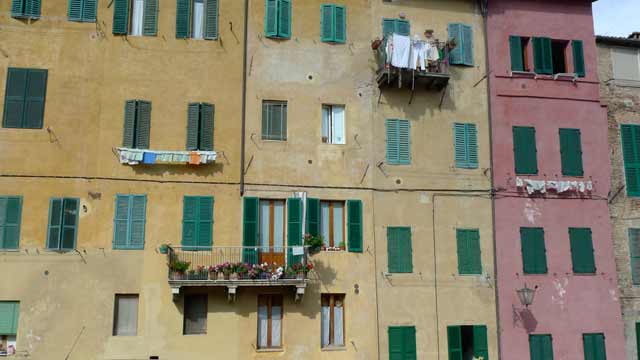
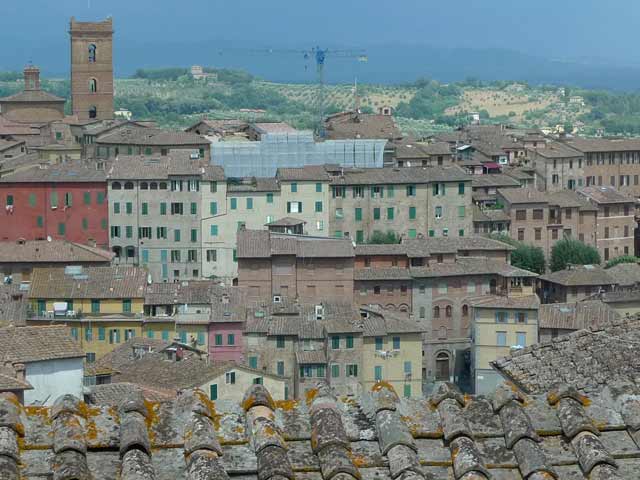
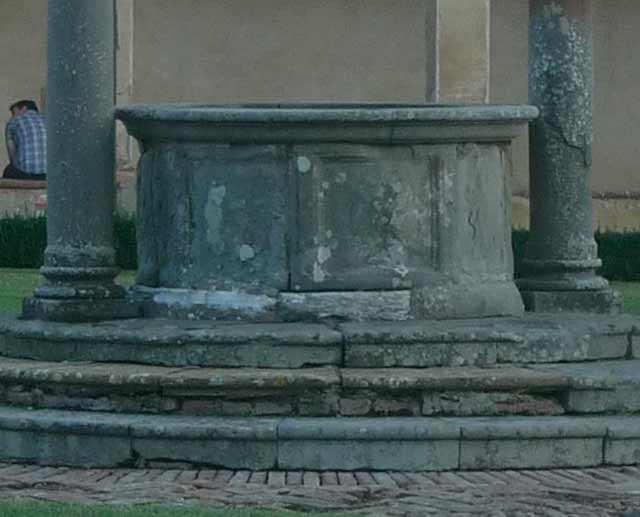

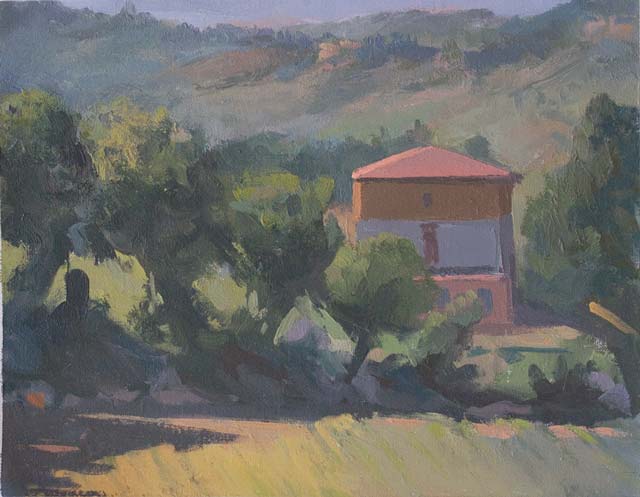
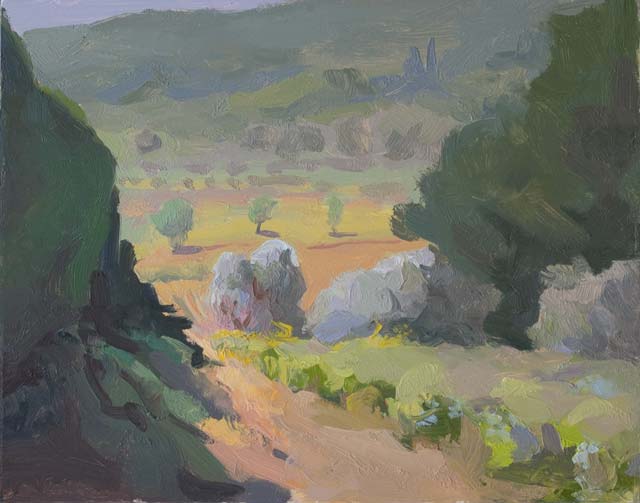
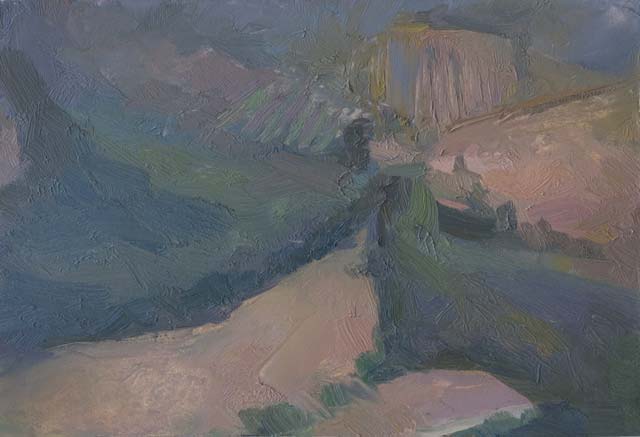
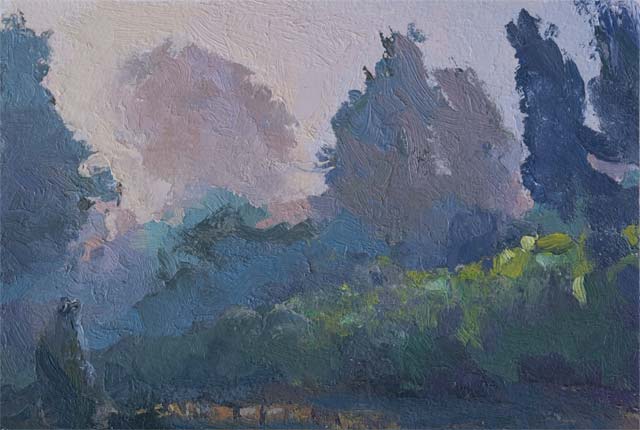

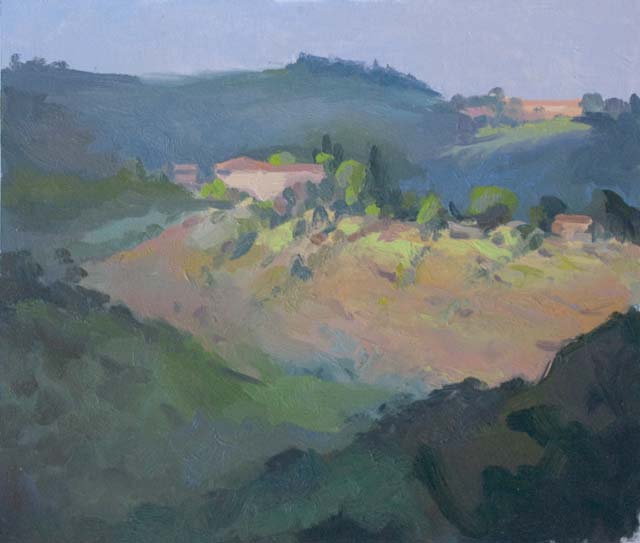
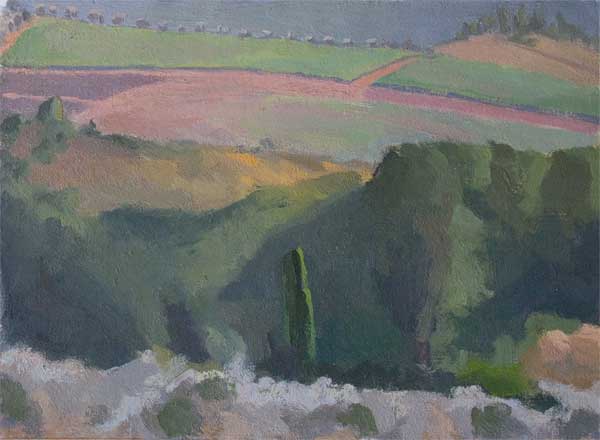
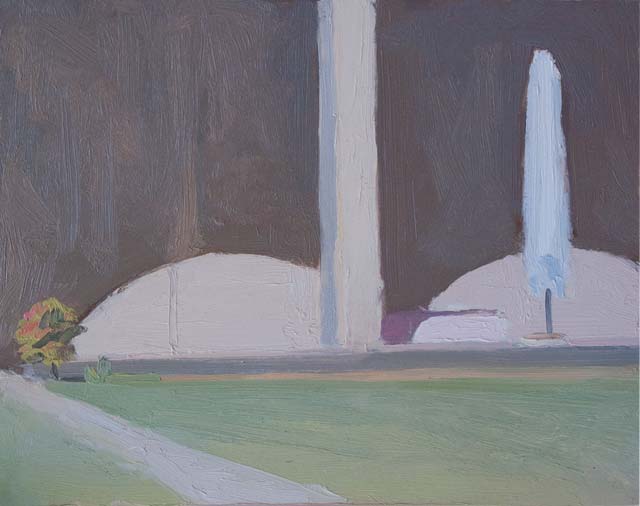
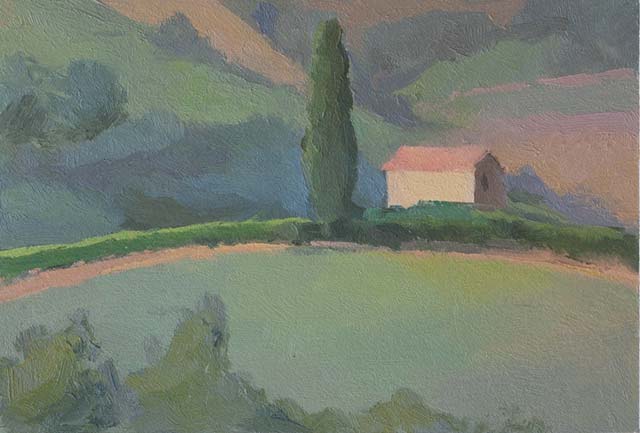
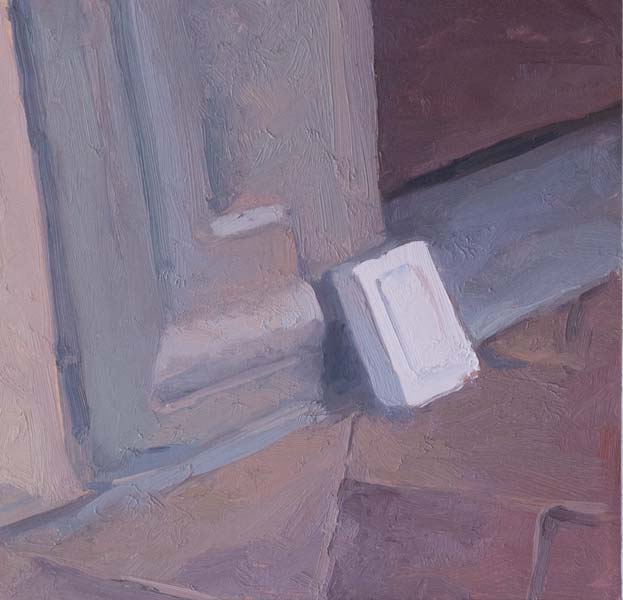
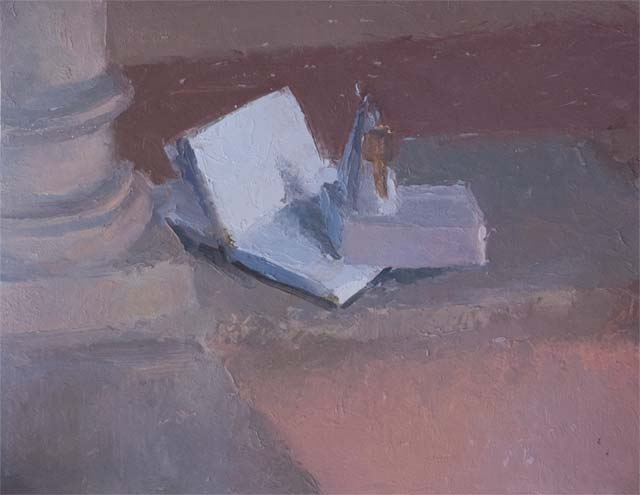




The sculpture of the guy hanging out under the sheep is probably Odysseus, escaping from the cave of the blinded Polyphemus.
Love the blog!
Yours,
Ocean
Great post! I was in Rome this summer and your photos brought back great memories. Also enjoyed your discussion of landscape painting. And seeing your own work. Thanks.
Thanks for posting this, Larry. I can tell you had a really productive trip. Love the paintings! And that photo of Lennart is just great.
What a great experience for you! The work looks fresh and your thoughts about it all are interesting. I hope you`ll write about any insights that were valuable to you.
Thank you Larry for sharing your thoughts, experiences, photos, and lovely paintings. Can see you were able to get much from this marvelous experience. Enjoyed this blog.
nice blog love the paintings I am have a website that I am going to showcase work terrenomar.com I travel to
Great to see your work. Looks like a wonderful experience, but a bit strange at the Pantheon. I was there in June for the Caravaggio exhibition. Such an impressive city and perfect location for a studio program.
That looks like a fantastic trip Larry! I recently missed an opportunity to take a workshop with Stuart Shils in Philly and I’m very depressed about it. I love his paintings. Welcome home!
Larry, looks as if the trip was a success and inspiration for you. Wonderful paintings, can’t wait to see and hear more! Glad it went well and am excited to see how your work at home will be influenced by all of this.
Thanks for your detailed report from Italy. The program and photos look great. Please consider sharing how you packed, what you brought, what you might do differently next time. Time to start saving!
Morandi Museum, Stuart Shills, Lennart Anderson and brought home some good paintings too! With a lineup like that it would have been a great trip if it was Rome Iowa. Glad to see you back and posting again. Looking forward to more.
Thanks everyone! I’m happy that people are finding this post interesting and thanks for the kind words about my paintings.
Ocean, Thanks for explaining the sheep and man sculpture – It is coming back to me, I’ll have to track down the full story sometime. I peeked at your website, nice work! cool to see a fellow Maya user who also paints.
Steven Goodman – cool that you were also in Rome this summer also Andrew Dickson – I was sorry to have missed the big Caravaggio exhibit only weeks before I got there but I did get to see quite a few stellar Caravaggio paintings at various churches and at the Villa Borghese Museum. Andrew good to hear from you maybe we can still get together this winter at the Salton Sea? I’m also wanting to see about trying to drum up interest in getting Stuart Stils to come to Southern California – or at least the West Coast do have one of his workshops. He says he can do if enough people commit.
Hank, Stuart is planning more workshops this fall I think, if you google it or check on his website you might still have a shot. He lives in the Philly area so I’m sure you can eventually hook up.
It is nice to see the Blog active again.
I have to say, those paintings you did sure are nice and shows that you must have really been immersed in the program and your surroundings. Boy oh boy I wish I was there, it clearly must have been life altering as far as painting goes and probably much more.
Since you just got back and are still unpacking to sort of speak I will only throw one question at you, if you don’t mind. That collage that Ken did of brick and tile fragments, stones and other elements to discuss his thoughts on color and painting has really grabbed at my curiosity and seems there must be an important lesson contained within it. So I really hope to hear some of your thoughts on that or a walkthrough of it. No hurry though and whenever you have time of course… maybe today ha ha just kidding.
So,,, you have seen a bunch of Giorgio Morandi, well that pretty well did it, now I am green with envy. What a great trip it must have been and welcome back.
Thanks TDK! It is indeed great this blog is back up and running. My apologies for the long delay but hopefully I will soon make up for lost time. One post I hope to do shortly will be an in-depth look at some of Ken’s thoughts on color. His thinking about color and painting in general really opened my mind up to new possibilities, I’m still trying to figure this out and assimilate it. Better to hear it straight from him rather than me mangling it all up. But as long as you don’t quote me… I think he was presenting it, in part, as another way to think about finding colors that best capture and sum up what you are seeing in the landscape – and how these shapes of color and getting the right clarity of tone cause them to relate together in surprising ways. The collage can be easily changed and can show you how your painting is better if left more open and not making each element so precious – that things should be fluid and more receptive to change, invention and play so that the whole painting is working as one.
While I’m getting together these planned interviews and posts I have several guest posts planned by Neil – he has been doing some terrific interviews and writing reviews of some really great painters in the UK while he is living there over the summer. The first interview should go up in a couple of days or so.
Thank you Larry for reminding me of “significant form”. I think not enough is said about this. I need to revisited it. Perhaps we could clarify what that means sometime. jim
Larry said…One post I hope to do shortly will be an in-depth look at some of Ken’s thoughts on color.
Boy I will be looking forward to that as colour is one of the hardest darn things to learn as it has taste, feel well a lot, so every little bit helps. You just never know what might trigger a fresh and new approach to this elusive subject.
Larry said…I think he was presenting it, in part, as another way to think about finding colors that best capture and sum up what you are seeing in the landscape – and how these shapes of color and getting the right clarity of tone cause them to relate together in surprising ways. The collage can be easily changed and can show you how your painting is better if left more open and not making each element so precious – that things should be fluid and more receptive to change, invention and play so that the whole painting is working as one.
Yes very interesting approach and very organic in its simplicity. I want to try it myself… maybe some small rocks down at the creek or stream will do it.
Larry said…While I’m getting together these planned interviews and posts I have several guest posts planned by Neil – he has been doing some terrific interviews and writing reviews of some really great painters in the UK while he is living there over the summer. The first interview should go up in a couple of days or so.
Looking forward to it. 🙂 What a great Blog!!!
Welcome back Larry!
What an amazing time in Italy!! as everyone has said, we are all green with envy about your experiences. I am very eager to hear about each of the teachers.
Hank Huffington – As far as Stuart Shils workshops go on the east coast, he is planning on a couple of workshops, one at the Pennsylvania Academy in mid october, another somewhere in Connecticut? and he also will work one on one with people. I’m planning on going to his PAFA workshop. see you there?
We’re all looking forward to your future posts Larry!
Ah what a great post! What a hoot re the guy wandering around nude. Love the pics, all the art work and wicked jealous you got to hang out and paint with Stuart Shils. I took a master class w him in Philadelphia this year and it is still having an effect on my work. Love the paintings and sure can’t wait to read & see more!
Hey I love this post. Lovely paintings as well. How does one become involved in this program?
There is a link in the post to the main school – Jerusalem Studio School – who ran this summer program. I’m not sure if they would have future summer programs worked out yet.